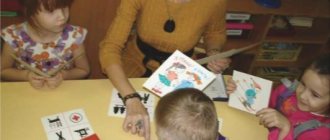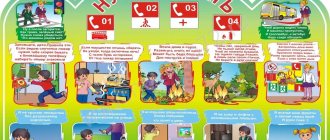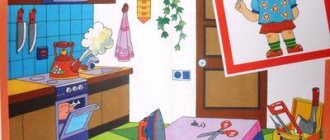Work experience on the topic: “Formation of the fundamentals of life in preschool children”
For three years, the priority direction of my activity has been to formulate the foundations of life safety in children. It's no secret that the current social situation is causing concern among people all over the planet. We feel special concern for our most defenseless citizens—little children. Adults must not only protect and protect the child, but also prepare him to face various difficult and sometimes dangerous life situations. Rules of behavior and safety measures are directly related to the living conditions of a person, be it a modern city or a rural area, a familiar home environment or the sea coast - each environment dictates completely different ways of behavior and, accordingly, precautions.
Safety is not just the sum of acquired knowledge, but the ability to behave correctly in various situations. Children may find themselves in unpredictable situations on the street or at home, so the main task of adults is to encourage their development of independence and responsibility.
Based on the above, the main content of the activity is:
- Formation in children of knowledge about careful handling of dangerous objects, and their application in practice;
- Formation of ideas about correct behavior when contacting strangers;
- Developing the foundations of a child’s ecological culture and establishing in him the value of caring for nature;
- Formation of healthy lifestyle values;
- Familiarity with the rules of safe behavior in the yard, on the street, on public transport, in the forest;
- Familiarization with traffic rules (this area is especially relevant, since, observing parents, we see that many of them walk along the roadway with their children, do not comply with traffic rules at all, thereby setting a negative example for their children).
The formation of safe behavior is inevitably associated with a number of prohibitions, while adults do not notice how often they repeat “You can’t”, “Don’t touch”, “Move away”. If there are too many prohibitions, the child will not be able to fulfill them fully. What to do? You can advise an adult to answer the following questions for himself:
- maybe I acted only by prohibition and the child did not understand the meaning of this rule?
- maybe the child did not have enough time to learn this rule?
- maybe I didn’t stimulate him enough to follow the rules, didn’t encourage him?
- Is my own behavior consistent, do I adhere to these rules myself?
- Am I demanding too much from the child (following rules and prohibitions)?
Education for safety is impossible without the cooperation of parents, but for this they need to be taught. I train and educate parents through various forms of work: parent meetings in a non-traditional form with the involvement of traffic police officers, conversations about the safe behavior of adults and children, I intensify the attention of parents to this problem through reporting statistics (how many children die on the roads every year, from adult violence, in forest, etc.) I pay special attention to visibility for parents when designing information stands in the locker room; I try to ensure that it is always colorful, bright, memorable, and attracts attention.
I use the following literature in my work: “Safety” - an educational and methodological manual on the basics of life safety for children of senior preschool age,” A.V. Avdeeva, O.L. Knyazeva, R.B. Sterkina, St. Petersburg, Detstvo-Press ; “ABC AU” - methodological recommendations for teaching children the basics of safety, O.R. Zhukova, G.N. Trushnina, St. Petersburg, Detstvo-Press; “Traffic Light” program, St. Petersburg, Detstvo-Press.
In the process of introducing these programs and methodological manuals, long-term plans for working with children of the junior, middle and senior groups were developed.
In the course of our work together with the children, we compiled the “Five NOTs”:
1. Don't go out alone.
2. Do not engage in conversation with strangers on the street or in public places.
3. Never agree to go with strangers and strangers, no matter how much they persuade you or what they offer you.
4. Don't trust a stranger if he says he knows your parents or offers to buy or give you something.
5. Don't get into a stranger's car.
The proximity of our settlement to the forest zone forces children to pay attention to the rules of behavior in the forest, what to do if you accidentally get lost. In this regard, various plans of the area were drawn up. In the process of joint activities, the children learned what they need to take with them into the forest, what rules they need to follow in the forest so as not to harm themselves and the inhabitants of the forest.
When working with children, I paid special attention to the daily routine, talked about why it needs to be followed: they played out various problematic situations that made it possible to understand that there is healthy food and unhealthy food; We thought with our children about how to take care of ourselves so that our body does not get angry.
Great importance is given to familiarizing children with fire safety rules (many children live in private houses with stove heating), we conduct training sessions on evacuating children from the kindergarten building, what to do if a fire occurs, we organize visits to the Fire Department in order to familiarize ourselves with the profession firefighter, examining special fire equipment, fire truck. The group created a “Safety Island” equipped with various visual aids for children. The central place is occupied by a traffic light and the 3 necessary numbers 01, 02, 03. In the locker room there is an exhibition of warning pictures “DON’T”. There are safety posters. Children display the acquired knowledge and ideas through role-playing games (“Firemen”, “Rescuers”, “Ministry of Emergency Situations”, “Policemen”), and in productive activities (a permanent exhibition of children’s works “The Safety of Our Lives” is organized in the kindergarten corridor). An obligatory ritual of our group is daily reading of educational and fiction literature, including those on safety (K. Chukovsky “Katausi and Mausi”, “Cat’s House”, riddles about sharp and fire-hazardous objects, S. Kustavikov “I Am Left Alone in the Forest” , S. Mikhalkov “The Cheerful Tourist”, A. Tolstoy “Fire Dogs”, S. Marshak “The Story of an Unknown Hero”, “Fire”, etc.) I regularly look at the modern magazine “Journey to the Green Light” with my children.
In order to determine the effectiveness of work in this direction, the following criteria were identified:
- the level of children’s ideas about actions in case of fire, when meeting strangers;
— knowledge of basic rules of behavior on the road, in the forest, in public transport;
— provision of first aid;
— ability to communicate with sharp and dangerous objects;
- ability to communicate with animals, knowledge of poisonous plants.
I would especially like to note that this work did not go unnoticed for parents: they increased their vigilance towards their children on the way to kindergarten, and began to follow traffic rules - they do not move on the roadway. The prospect of working with adults is: increasing the attention of parents to the rules for transporting children in personal transport (ensuring the safety of children through car seats).
The most important result in working with children was that they realized that the most important thing for a person is his life and health, so they need to be protected!


